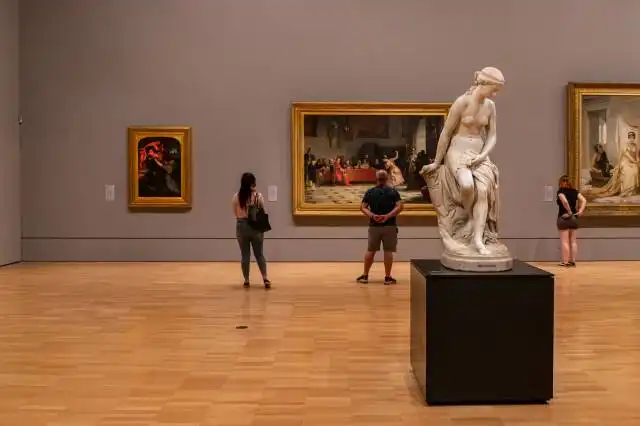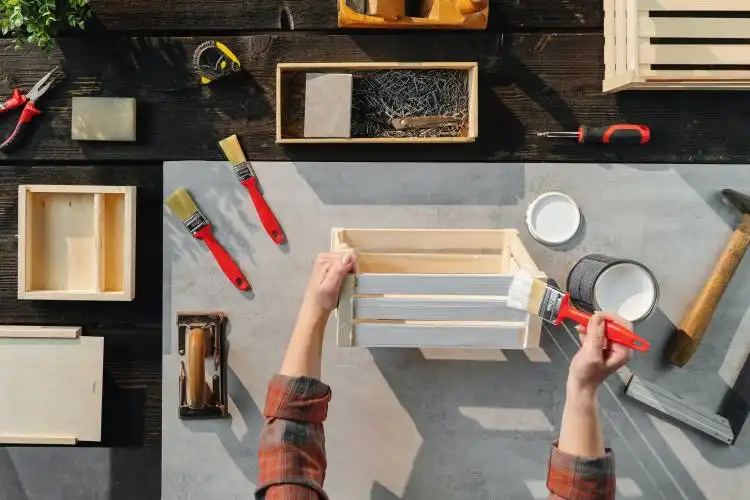Start a Mural Painting Business
Turning the World into Your Canvas: Your Mural Painting Business Journey
| Updated


MURAL PAINTING BUSINESS
Unleash your artistic prowess with a mural painting business, transforming ordinary walls into extraordinary canvases. This venture utilizes your artistic skills to create custom, large-scale artworks for both individuals and businesses. Always wanted your mark on the cityscape? Your next masterpiece could be seen by thousands daily on the side of a bustling business or a serene park wall. Prepare those brushes, the world is your easel!
Jump to Business Plan
RELATED BUSINESS IDEAS
Browse ALL Arts & Crafts Business Ideas
Discover Your Perfect Domain
Unlock the door to your online success with our hand-picked selection of premium domain names. Whether you're starting a new venture or rebranding an existing one, the right domain can set the tone for your digital presence. Browse through our curated list, each with its unique potential to enhance your brand's visibility and credibility.
MURAL PAINTING MINI BUSINESS PLAN
This a quick reality check to help you identify the strengths and weaknesses of your business concept before you dive in.
Business Analysis: Mural Painting Business
Expected Percent Margin:
- Gross Margin: 70-80%
- Net Profit Margin: 30-40%
Earnings Expectations:
- Daily Earnings: $200 - $800 (Based on project scope)
- Weekly Earnings: $1,000 - $4,000 (5 working days)
- Monthly Earnings: $4,000 - $16,000
- Annual Earnings: $48,000 - $192,000
Actions to Hit Those Numbers:
Material Management:
- Initial Investment: Startup costs including paint supplies and licensing can range from $2,000-$5,000.
- Supplier Network: Connect with reliable suppliers to access high quality, cost-effective materials.
Marketing and Customer Acquisition:
- Portfolio Development: Create a comprehensive portfolio that showcases your range and talent.
- Social Media: Post regularly showcasing your work and documenting your process.
- Networking: Attend local networking events or art shows to attract potential customers.
Delivering Projects:
- Efficiency: Aim to complete at least one small project per day or a large project per week.
- Quality: Focus on delivering high-quality work that meets (or exceeds) client expectations.
Cost Control:
- Material cost: Keep materials cost under control by buying in bulk or taking advantage of discounts.
- Business Operations: As a start, keep the team small, maybe you and an assistant, until the business grows.
Business Operations:
- Working Hours: Prepare for unconventional working hours. Some projects may require that you work after business hours or on weekends.
- Project Volume: Aim for a minimum of 10-15 small projects every month or 2-3 large projects.
Again, these are just estimated projections and can vary vastly. It's essential to create a detailed business plan that's tailored to your specific circumstances and creative niche. Always consult with a business advisor or mentor for personalized advice.
NOT WHAT YOU HAD IN MIND? Here are more ideas



Browse ALL Arts & Crafts Business Ideas
Grab Your Business Website Name
Before you get caught up in the whirlwind of setting up your business, invest in a domain name. It's a small but significant step that lays the foundation for your brand and makes it easier for customers to find and trust you. Just like you wouldn't build a house without securing the land first, don't build a business without securing your domain name.
"Why? Can't that wait?" Here's why it shouldn't
Step 1: Determine if the Business is the Right Endeavor
Breakdown of Startup Expenses
Before starting a mural painting business, it is important to understand the startup expenses associated with the venture. This includes the cost of supplies, such as paint, brushes, and other materials, as well as the cost of renting or purchasing a space to work from. Additionally, the cost of advertising and marketing should be factored in, as well as any licensing or permits that may be required. It is important to create a comprehensive budget before starting a mural painting business to ensure that all costs are accounted for.
Breakdown of Ongoing Expenses
In addition to startup expenses, it is important to consider the ongoing expenses associated with running a mural painting business. This includes the cost of supplies, such as paint, brushes, and other materials, as well as the cost of renting or purchasing a space to work from. Additionally, the cost of advertising and marketing should be factored in, as well as any licensing or permits that may be required. It is important to create a comprehensive budget before starting a mural painting business to ensure that all costs are accounted for.
Examples of Ways to Make Money
There are a variety of ways to make money with a mural painting business. One option is to charge a flat fee for each mural project. Alternatively, mural painters can charge an hourly rate for their services. Additionally, mural painters can offer their services to businesses, such as restaurants, hotels, and retail stores, for a one-time fee or a recurring fee. Finally, mural painters can also create and sell prints of their work, either online or in person.
Step 2: Name the Business
When it comes to naming a business, it is important to come up with something that is memorable and unique. It should also reflect the type of business that is being started. Some tips for coming up with a great name for a mural painting business include:
- Brainstorming: Take some time to brainstorm potential names that could be used for the business. Consider words that are related to the type of business being started, as well as words that are catchy and memorable.
- Research: Once some potential names have been identified, it is important to research them to make sure that they are not already being used by another business.
- Get Feedback: Once a few potential names have been identified, it is a good idea to get feedback from friends and family to see which name they like best.
- Consider the Future: When coming up with a name, it is important to consider the future of the business. The name should be something that can grow with the business and not be too limiting.
- Keep it Simple: It is important to keep the name of the business simple and easy to remember. Avoid long, complicated names that people may have difficulty remembering.
Step 3: Create a Business Plan
Creating a business plan is essential for any business, and a mural painting business is no exception. The business plan should include a mission statement, a description of the services offered, a market analysis, a financial plan, and a plan for marketing and promotion.
The mission statement should be a concise description of the purpose of the business and what it hopes to achieve. It should be no more than a few sentences long and should be easy to remember.
The services offered should include a description of the types of mural painting services available, the cost of those services, and the estimated time it will take to complete the project.
The market analysis should include an overview of the mural painting industry, the target market, and the competition. It should also include an analysis of the strengths, weaknesses, opportunities, and threats of the business.
The financial plan should include a breakdown of startup expenses, ongoing expenses, and ways to make money. It should also include a budget for marketing and promotion.
The plan for marketing and promotion should include a description of the methods used to reach potential customers, such as advertising, social media, or word-of-mouth. It should also include a timeline for when the marketing and promotion activities will take place. Additionally, it should include a plan for tracking the effectiveness of the marketing and promotion efforts.
Step 4: Obtain Necessary Licenses and Permits
In order to start a mural painting business, there are several licenses and permits that must be obtained. Depending on the location, these may include a business license, a permit to operate a business, a zoning permit, and a sales tax permit. It is important to check with the local government to determine which licenses and permits are necessary.
How to Obtain Licenses and Permits
Once the necessary licenses and permits have been identified, the next step is to apply for them. This can be done online or in person at the local government office. It is important to make sure all of the paperwork is filled out correctly and all fees are paid in full. Once the paperwork has been submitted, the business will be ready to operate.
Cost of Licenses and Permits
The cost of licenses and permits can vary depending on the location. Generally, the cost of a business license is around $50, while a permit to operate a business can cost anywhere from $100 to $500. A zoning permit may cost up to $200, and a sales tax permit may cost up to $50. It is important to factor in these costs when budgeting for the business.
Benefits of Obtaining Licenses and Permits
Obtaining the necessary licenses and permits is an important step in starting a mural painting business. It ensures that the business is operating legally and is in compliance with local laws. It also provides protection for the business and its owners in the event of any legal issues. Additionally, having the proper licenses and permits can help to build credibility with customers and potential partners.
Step 5: Secure Financing
Securing financing for a mural painting business can be a challenge, but there are several options available. One option is to apply for a traditional loan from a bank or credit union. This option requires a business plan and a good credit score. Another option is to apply for a Small Business Administration (SBA) loan, which is a government-backed loan that can provide more favorable terms than a traditional loan. Additionally, some businesses may be eligible for grants from local or state governments, which can provide a great source of funding. Finally, some entrepreneurs may choose to use their own savings or investments to finance their business.
Tips for Securing Financing
When applying for a loan, it is important to have a solid business plan that outlines the goals of the business and how the loan will be used. Additionally, it is important to research the different loan options and compare interest rates and repayment terms. It is also important to have a good credit score, as this will make it easier to secure financing. When applying for a grant, it is important to research the different grant programs and make sure that the business meets all of the eligibility requirements. Finally, it is important to make sure that the business has enough capital to cover all of the startup and ongoing expenses.
Step 6: Market the Business
One of the most important steps in starting a mural painting business is marketing. This is how potential customers will find out about the business and what services it offers. There are many ways to market a mural painting business, including creating a website, using social media, and attending local events.
Creating a website is a great way to showcase the work the business has done and allow potential customers to easily contact the business. A website should include a portfolio of the business’s work, contact information, and a description of the services offered. Additionally, the website should be optimized for search engines so that potential customers can easily find it.
Social media is another great way to market a mural painting business. Platforms such as Facebook, Instagram, and Twitter are great for connecting with potential customers and sharing updates about the business. It is important to post regularly and engage with followers to build relationships and trust.
Attending local events is also a great way to market a mural painting business. Events such as art festivals, farmers markets, and street fairs are great places to meet potential customers and show off the business’s work. Additionally, these events are a great way to network with other local businesses and build relationships.
Finally, word of mouth is a great way to market a mural painting business. Encouraging customers to leave reviews and share their experiences with others is a great way to spread the word about the business. Additionally, offering discounts to customers who refer others is a great way to incentivize word of mouth marketing.
Step 7: Hire Employees
When hiring employees, it is important to consider the skills, experience, and qualifications of the potential employee. It is also important to consider the cost of hiring an employee, as well as the cost of training them. Additionally, it is important to create a job description and to have a clear understanding of the duties and responsibilities of the employee. It is also important to have a clear understanding of the employee’s pay and benefits.
Benefits of Hiring Employees
Hiring employees can be beneficial for a mural painting business, as it can help to increase productivity and efficiency. Employees can help to take on some of the workload, allowing the business owner to focus on other aspects of the business. Additionally, having employees can help to create a sense of team and camaraderie, which can be beneficial for morale.
Finding Employees
Finding qualified employees can be a challenge. It is important to advertise the job opening in the right places, such as job boards, social media, and local newspapers. Additionally, it is important to network and reach out to potential candidates. It is also important to conduct interviews and background checks to ensure that the right candidate is chosen.
Training Employees
Once the right candidate is chosen, it is important to provide them with the necessary training. This can include providing them with information on the business, the products and services offered, and the procedures and policies of the business. Additionally, it is important to provide them with the necessary tools and resources to help them succeed in their role.
Step 8: Set Up Accounting System
An accounting system is an essential part of any business, and a mural painting business is no different. It is important to set up an accounting system that will track income and expenses, as well as provide financial statements. This will help the business owner to understand the financial health of the business and make informed decisions.
Choose an Accounting Software
When setting up an accounting system for a mural painting business, the first step is to choose an accounting software. There are many different types of accounting software available, and it is important to choose one that is user-friendly and meets the needs of the business. It is also important to make sure the software is compatible with the business’s other systems, such as its website and payment processing.
Set Up Bank Accounts
The next step is to set up bank accounts for the business. This includes a checking account for day-to-day operations, as well as a savings account for long-term investments. It is important to choose a bank that offers low fees and good customer service. It is also important to make sure the bank is FDIC insured.
Establish a Bookkeeping System
Once the accounting software and bank accounts have been set up, the next step is to establish a bookkeeping system. This includes setting up a chart of accounts, which is a list of all the accounts the business will use to track income and expenses. It is also important to set up a system for recording transactions, such as invoices, receipts, and payments.
Hire an Accountant
Finally, it is important to hire an accountant to help with the business’s financials. An accountant can help with setting up the accounting system, preparing financial statements, and filing taxes. It is important to hire an accountant who is knowledgeable and experienced in the field of mural painting.
Step 9: Develop a Pricing Strategy
When it comes to pricing your mural painting services, there are a few different strategies you can use. You can charge a flat rate for each mural, a per-square-foot rate, or an hourly rate. You can also offer discounts for larger projects or for repeat customers. It's important to remember that you should always factor in the cost of materials and any other expenses associated with the project when setting your prices.
Considerations for Setting Prices
When setting your prices, you should consider the cost of materials, the amount of time it will take to complete the project, and the level of difficulty of the project. You should also factor in the cost of any additional services you may be offering, such as touch-ups or repairs. Additionally, you should take into account the local market and the prices that your competitors are charging.
Ways to Increase Revenue
In addition to charging for your mural painting services, you can also increase your revenue by offering additional services such as touch-ups and repairs. You can also offer classes and workshops to teach others how to paint murals. Additionally, you can sell prints of your murals or offer commissions for custom murals. Finally, you can also create and sell merchandise featuring your artwork.
EXPLORE MORE CATEGORIES
Browse ALL Business Idea Categories
TAKE THE NEXT STEPS










